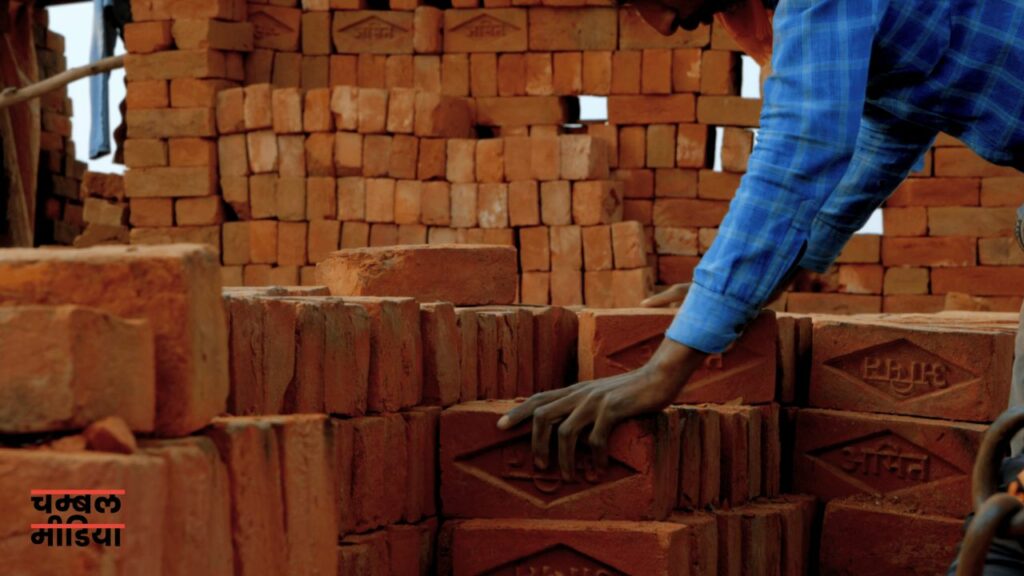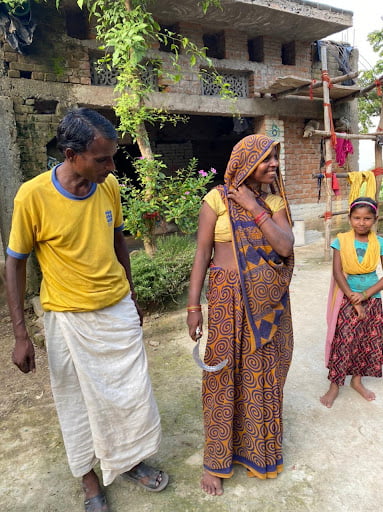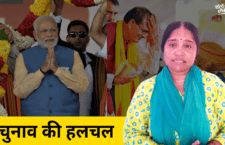The brick kiln isn’t a choice; it is a compulsion. “When the kilns are shut, sometimes I wake up early to go to work, sometimes late when there’s no work. While I’m economically better off now after working at the kiln, the cycle seems unending,” he remarks.
“I want a life where I don’t have to migrate for work,” says Mamta, a brick kiln worker from Bahadurgarh. Her sister-in-law, Sobha, echoes this sentiment. A landless worker from Jamnagar, Sobha speaks of the difficult choices she’s made for survival, including delivering her children within the confines of a brick kiln. “My whole family is involved, including my children, who are present at kilns,” she says, emphasising the extent of the issue.
Bundelkhand, a historical region in Central India, stretches its arid lands across the states of Uttar Pradesh and Madhya Pradesh. For many years now, the region has been witnessing a large-scale migration of its residents, especially the youth, due to severe joblessness.
A 2018 research titled Caste and development: Contemporary perspectives on a structure of discrimination and advantage by David Mosse states how members of marginalised castes (Dalits and OBCs), are often excluded from jobs and opportunities. This has resulted in a situation where members of marginalised castes mostly end-up in low-paying manual labor jobs.
An article published in Centre for Policy Research, authored by Shamindra Nath Roy and Eesha Kunduri, examines circular migration in India, in the context of Brick kiln workers. The article suggests that close to half of the total migrants (47%) in brick-kilns are scheduled castes (SCs). Supporting the findings of the article, Kavita Bundelkhandi, the Editor-in-Chief of Khabar Lahariya says, “There was a time when the whole of Dalit bastis would get empty from villages, as the people living there would migrate to Brick Kilns in search of work.”
These kilns, fired up in September and October, work relentlessly through the summer months until May, breaking only for the monsoon season. The workers, hired as family units, receive an advance payment based on the number of family members who can work, including children. They are then bound to the kiln and expected to work off the debt incurred. The workers are compelled to take these debts due to no means of income in their villages. Once a kiln is fired up, it’s fed with fuel and bricks without interruption until the season ends. This labor-intensive process requires workers to mold bricks, transport them to the kiln, layer them, and add fuel to the kiln—all by hand.
Behind the production of these bricks lies the toil of laborers coming from Dalit families – Sobha, Mamta, Aarti, Anil, and Ramhit. They narrate tales that mirror the collective experience: promises of better facilities, broken dreams, health risks, and looming uncertainty. Their stories reveal the stark realities of the brick kiln industry, where the labourers along with their children, are working under harsh conditions, often for meager pay and with minimal access to basic amenities such as water, healthcare, and education.
Migration and Unemployment
As a young man of 24, Anil from Chitrakoot has spent almost half his life working in brick kilns. “I wanted to study,” he says with a tinge of regret, “but our financial condition was dire, with my father being the only earner so I couldn’t study beyond 3rd/4th grade.” From owning a 2-bigha land and envisioning a life of farming, Anil’s trajectory shifted dramatically towards the brick kilns. The land, which was supposed to be the bedrock of his family’s sustenance, couldn’t feed the 12 mouths. “Our small piece of land can never be sufficient. There is no choice but to resort to other modes of livelihood.”
The brick kiln isn’t a choice; it is a compulsion. “When the kilns are shut, sometimes I wake up early to go to work, sometimes late when there’s no work. While I’m economically better off now after working at the kiln, the cycle seems unending,” he remarks.
“If I miss my village in between working in the brick kiln, I go alone to visit it. When I go back to my village, I do odd jobs, like farming. I even know the people who work with me for those 10-15 days. When I am back at the kiln, I forget about everything else,” he says quietly.
To an uninformed eye, his composed exterior might suggest a certain peace. Yet beneath lies a deep-rooted resignation, a narrative scripted by the oppressive social reality. For him, aspirations outside this predefined path feel unattainable. “I don’t think there should be any other system other than the one that is our reality. What is the point of thinking of an alternative reality?” he says.
Landlessness and Education
Anil’s story underscores the tussle between agrarian dreams and the harsh social realities of survival in modern-day Bundelkhand.
The struggle resonates with Ramhit of Chaukanpurwa and Banda too, albeit layered with aspirations for the next generation. A determined father, Ramhit dreams of a brighter future for his son, and he is ensuring that his son gets a good education. “I want to end this vicious cycle with him,” he shares passionately.
Ramhit’s son is pursuing his graduation from Badosa’s Swargeeya Kanta Prasad Degree College. With no land to cultivate and a family to support, he gravitated towards the kilns. The aspirations of parents like Ramhit are pinned on the next generation, hoping to break the cycle through education.
But landlessness isn’t just an economic problem; it is intricately tied to caste. With a considerable population of the brick kiln workers identifying as Dalits, they are historically marginalised and devoid of landownership and rights. Ramhit says that if his family owned land, he would not be in the position of annually migrating for work. In terms of occupation, their first choice would always be agriculture. “Most people who work in brick kilns leave as soon as October comes. But we personally prefer to stay till January in our villages, as the months of October and November give us the opportunity of cutting grown rice crops from farms. Data from the National Sample Survey (NSS) shows that 70% of the migrant workers currently employed in brick kilns, were previously employed in the agricultural sector.
The 38th Round (1983) of the National Sample Survey (NSS) report states that 77% of rural households depend on the agricultural sector to sustain their livelihoods. But the past few decades have observed the decline of this dependency. According to the Periodic Labour Force Survey (PLFS) report of 2018-19, only 50% of rural households depend on agriculture.
Ramhit’s family have often practised the crop-sharing farming called Batai. However, this sharecropping system too, has its set of demerits. Some backward caste farmers feel that sharecropping often leads to an indirect form of slavery under landowners, who mostly happen to be upper-caste.
Ramhit’s experience is telling of broader systemic attitudes. The government has, under the Mahatma Gandhi National Rural Employee Guarantee Act employment and social security scheme, allocated job cards for villagers who have registered under the local Gram Panchayat. The cards are meant to provide employment for up to 100 days a year. But complications are afoot in implementing it on the ground. “The MGNREGA card promises 100 days of work, but what about the rest of the year?” Ramhit asks rhetorically. The brick kiln, despite its arduous nature, offers him work for eight months and a sense of stability in an otherwise unstable world.
Life at the Kiln
Promises of basic facilities like water, electricity, and toilets are made to the workers, before their work is commenced. But for many, like Mamta and Aarti, these promises remain unfulfilled. Mamta recounts a chilling tale from a brick kiln in Bahadurgarh. “There was one day when all of us were trapped inside the brick kiln furnace, all our kids and all the workers,” she narrates. “All of our jhuggis fell down. Some of the workers’ legs were also got injured. That was the most difficult day of my life.”The owner of the brick kiln was unperturbed.” If we voiced our concerns, he’d threaten to evict us without pay,” she shares.
“When the brick kiln owner used to recruit us, he would say that you’ll get all sorts of facilities like electricity, drinking water, and usable toilets,” Mamta says. “But we don’t even get water to drink. You can easily stay thirsty because you will not get water so easily. You have no access to drinking or bathing water.”
Almost everything is contingent upon the brick kiln owner and the contractor’s word. Often, the most challenging part of such a profession is the wage. “Our wage system was Rs 500 per day. If I complain too much, my payment gets delayed by 10-15 days,” Mamta says. Aarti, a 30-year-old from Bhavanipur, shares Mamta’s pain. She says, “Sometimes we get ration food. But there’s no official check from the government,” she shares, lamenting the lack of basic facilities and the distant, often elusive promise of proper healthcare.
Anil, contrary to others, mentions receiving the promised facilities, underscoring the varied experiences at different kilns. “I have been working for close to 10 years. I’ve been to Rajasthan, Pratapgarh, Mirzapur, and other such areas. I work as a patheda. I go with my family. We get all kinds of facilities, such as water, electricity, and a toilet. If we get sick, we seek out doctors in a nearby area. We have a ration card, that is our parents’,” he says.
Ramhit, who has been migrating to the brick kilns for several years knows his way to work around the system, and stand up for his rights. He has, once, demanded for washrooms inside the kiln premises for the safety of women. “I gathered men, and I made sure that the kiln owner listened to us.”
Amidst these hardships, Ramhit finds solace in community bonding during festivals in the kiln space. When it’s time for festivals like Holi or Eid, kiln owners have a practice of giving some money in advance for laborers to enjoy their time in an unfamiliar land. Ramhit particularly remembers the number of melas he’s visited with his family. “During festivals, we visit temples, fostering a sense of camaraderie.” The practices make the laborers feel familiar and safe, just like in their own homes.
A change needed in the socio-economic systems
How can we better support individuals like Mamta, Ramhit, Anil, Sobha, and Aarti, whose stories are entwined with the complexities of caste and labor exploitation? What regulations can be established in the brick kiln industry to protect these Dalit workers, who venture miles away from home seeking sustenance? And what measures can imbue them with a sense of belonging when they are so far from familiar territories?
Khabar Lahariya’s Geeta Devi unravels the factors pushing many towards the brick kilns. “In Bundelkhand, choices are limited,” she observes pointedly. “For the Dalit communities, landlessness is not just about economics, but a manifestation of historic caste inequalities. Agriculture, thus, becomes an elusive dream with both socio-economic and climatic constraints.”
Geeta’s insights unveil the layers of this intricate issue. “The past few decades have witnessed an increase in migration to brick kilns, mostly from backward castes. Alongwith Dalits, you will also find several people from the OBC communities migrating to the kilns due to lack of employment opportunities.” she asks.
“Brick kilns, despite their own set of challenges, at least promise longer employment durations. However, this comes at the cost of rights, dignity, and often unpaid wages,” she says. Through her lens, she doesn’t just critique but demands an urgent re-examination of these socio-economic systems, keeping caste at the forefront.
Through the tales of Anil, Ramhit, Mamta, Sobha, Aarti, and Geeta, Bundelkhand’s narrative takes shape. As agriculture becomes a less viable source of sustenance and factories remain absent, brick kilns rise as the inevitable choice. This transition from an agrarian core to a brick kiln-reliant economy marks a significant shift in the region’s socio-economic fabric.
This story is part of a media series under Buniyaad, a movement towards a foundational change for a just transition in the brick kln sector, where we will bring social, economic and environmental stories related to equitable change in the brick kiln industry of Uttar Pradesh.
The main objective of this campaign is to work with brick kiln owners, workers, organizations, technical experts and government policy makers to find clean technology for the industry, which can reduce environmental pollution and center and ensure societal welfare benefits for individuals and communities associated with the industry. The Climate Agenda, 100% Uttar Pradesh Network and Chambal Media are a part of this campaign.
This article is written by Hameeda Syed.
‘यदि आप हमको सपोर्ट करना चाहते है तो हमारी ग्रामीण नारीवादी स्वतंत्र पत्रकारिता का समर्थन करें और हमारे प्रोडक्ट KL हटके का सब्सक्रिप्शन लें’




